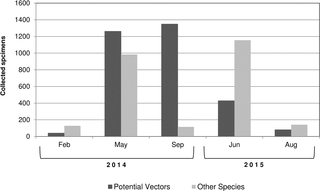PLOS Neglected Tropical Diseases ( IF 3.4 ) Pub Date : 2017-11-06 , DOI: 10.1371/journal.pntd.0006029 Victor Zorrilla , Maxy B. De Los Santos , Liz Espada , Rocío del Pilar Santos , Roberto Fernandez , Albino Urquia , Craig A. Stoops , Sarah-Blythe Ballard , Andres G. Lescano , Gissella M. Vásquez , Hugo O. Valdivia

|
Background
Cutaneous leishmaniasis (CL) is an important health problem in the New World affecting civilian and military populations that are frequently exposed in endemic settings. The Peruvian region of Madre de Dios located near the border with Brazil is one of the most endemic CL regions in South America with more than 4,451 reported cases between 2010 and 2015 according to the Peruvian epidemiology directorate. However, little is known regarding the diversity and distribution of sand fly vectors in this region. In this study, we aimed to characterize the sand fly fauna in this endemic setting and identify sand fly species naturally infected with Leishmania possibly involved in pathogen transmission.
Methods
Sand fly collections were carried out during 2014 and 2015 in the communities of Flor de Acre, Villa Primavera, Mavila and Arca Pacahuara using CDC light traps and Shannon traps. Collected specimens were identified and non-blood-fed females were selected for Leishmania infection screening using kinetoplastid DNA-PCR (kDNA-PCR) and nested Real time PCR for species identification.
Results
A total of 10,897 phlebotomines belonging to the genus Lutzomyia (58 species) and Brumptomyia (2 species) were collected. Our study confirmed the widespread distribution and abundance of Lutzomyia (Trichophoromyia) spp. (24%), Lu. whitmani (19.4%) and Lu. yucumensis (15.8%) in the region. Analysis of Shannon diversity index indicates variability in sand fly composition across sites with Villa Primavera presenting the highest sand fly diversity and abundance. Leishmania screening by kDNA-PCR resulted in 45 positive pools collected from Flor de Acre (34 pools), Mavila (10 pools) and Arca Pacahuara (1 pool) and included 14 species: Lu. yucumensis, Lu. aragoi, Lu. sallesi, Lu. sherlocki, Lu. shawi, Lu. walkeri, Lu nevesi, Lu. migonei, Lu. davisi, Lu. carrerai, Lu. hirsuta, Lu. (Trichophoromyia) spp., Lu. llanosmartinsi and Lu. whitmani. Lutzomyia sherlocki, Lu. walkeri and Lu. llanosmartinsi had the highest infection rates (8%, 7% and 6%, respectively). We identified Leishmania guyanensis in two Lu. whitmani pools, and L. braziliensis in two Lu. llanosmartinsi pools and one Lu. davisi pool.
Conclusions
Based on our collections there is high sand fly diversity in Madre de Dios, with differences in sand fly abundance and species composition across sites. We identified 14 sand fly species naturally infected with Leishmania spp., having detected natural infection with L. (V.) guyanensis and L. (V.) braziliensis in three sand fly species. These results suggest the presence of several potential vectors that vary in their spatial and geographical distribution, which could explain the high prevalence of CL cases in this region.
中文翻译:

秘鲁东南亚马逊自然感染利什曼原虫的沙蝇的分布和鉴定
背景
皮肤利什曼病(CL)是新世界中的一个重要健康问题,影响了经常在地方性环境中感染的平民和军人。秘鲁流行病学调查局称,位于巴西边境附近的秘鲁Madre de Dios地区是南美最流行的CL地区之一,2010年至2015年之间报告的病例超过4,451例。然而,关于该地区沙蝇媒介的多样性和分布知之甚少。在这项研究中,我们旨在表征这种流行环境中的沙蝇动物群,并确定自然感染利什曼原虫的沙蝇物种,可能与病原体传播有关。
方法
在2014年至2015年期间,使用CDC诱捕器和Shannon诱捕器在Flor de Acre,Villa Primavera,Mavila和Arca Pacahuara社区进行了沙蝇收集。鉴定收集的标本,并选择非血性雌性进行利什曼原虫感染的筛查,方法是使用运动质体DNA-PCR(kDNA-PCR)和巢式实时PCR进行物种鉴定。
结果
总共收集了10897个属于Lutzomyia属(58种)和Brumptomyia(2种)的放血菌。我们的研究证实了Lutzomyia(Trichophoromyia)spp的广泛分布和丰富。(24%),陆。惠特曼(19.4%)和卢。该区域有yucumensis(15.8%)。Shannon多样性指数的分析表明,不同地点的沙蝇组成存在差异,其中Villa Primavera呈现最高的沙蝇多样性和丰度。通过kDNA-PCR筛选利什曼原虫,从Flor de Acre(34个库),Mavila(10个库)和Arca Pacahuara(1个库)收集了45个阳性库,包括14种:鲁。yucumensis,陆。aragoi,陆。萨勒西,卢。夏洛克,卢。肖威,卢。walkeri,鲁nevesi,陆。migonei,陆。戴维斯,卢。卡雷莱,卢。毛,陆。(Trichophoromyia)spp。,Lu。llanosmartinsi和Lu。惠特曼尼。Lutzomyia sherlocki,陆。华克里和卢。llanosmartinsi的感染率最高(分别为8%,7%和6%)。我们在两个Lu中鉴定了Leishmania guyanensis。whitmani池和大号。巴西鲁两路。llanosmartinsi游泳池和一卢。戴维斯游泳池。
结论
根据我们的收集,马德雷德迪奥斯的沙蝇多样性很高,不同地点的沙蝇丰度和物种组成存在差异。我们确定了14种自然感染了利什曼原虫的沙蝇种,并检测到了L的自然感染。(V)guyanensis和大号。(V.)braziliensis在三种沙蝇中。这些结果表明存在几种可能的载体,其空间和地理分布各不相同,这可以解释该地区CL病例的高患病率。











































 京公网安备 11010802027423号
京公网安备 11010802027423号